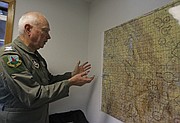Help from above
A simulated earthquake scenario in the Silver Valley had Civil Air Patrol teams refining their life-saving and person-locating abilities Saturday morning.
About 30 CAP senior members and cadets from Idaho, Montana and Washington participated in the earthquake drill, which included radio communication training, infrastructure damage assessment and aerial missions over the Interstate 90 corridor to monitor the status of the municipalities from Hayden to Mullan Pass.
"We try to do review training to be sharpened up on our skills," said Cadet Maj. Ethan Hanson, 19, who has been involved with CAP for six years. "I don’t think I’ve ever done one where there wasn’t new stuff that I was learning."
The volunteer, nonprofit organization supports the Air Force and other emergency responders when disaster strikes, such as missing persons, downed planes or natural catastrophes.
"There are times where the manpower is needed, and the aircraft we can provide for essentially none of the cost that other agencies charge because our funding comes from national," Hanson said. "We’re able to provide manpower in the form of ground teams or in the form of air crews that are up searching doing aerial reconnaissance that other agencies charge considerable amounts for. We’re able to provide that for free."
Col. Bob Kirkwood joined CAP when he was a boy in 1962. He spent 25 years as a pilot in the Air Force and flew for airlines and the Federal Aviation Administration for several years after retirement.
He said an innate sense of duty to others is ultimately why people get involved in CAP, regardless of whether they have a military or aviation background.
"When people that have been involved in actual saves where they've been credited with saving lives, they get a lot of gratification," he said. "Altruistically, it's to try to save lives and limit suffering. But, on the other hand, for me, it's challenging and it's fun."
Hanson, a Classical Christian Academy graduate, experienced that gratification when he helped save two people on a previous mission in Nampa.
"There were two fisherman who got lost," he said. "We did recover them alive. Cold, but alive. That was very, very rewarding in that sense, knowing we helped aid in their recovery."
Lt. John Gregory, who flew the air mission with Hanson, said another team had placed a damaged aircraft frame in the woods with an emergency locator transmitter for the flight crews to find as part of their training.
"They loaded that thing up on the trailer and they're up there waiting for us to go find them," he said.
The purpose of this training is to strengthen the coordination between various agencies and to continue to train to the highest standards of readiness for the emergency services mission assigned to CAP by Congress in 1947.
Info: www.cdacap.us



